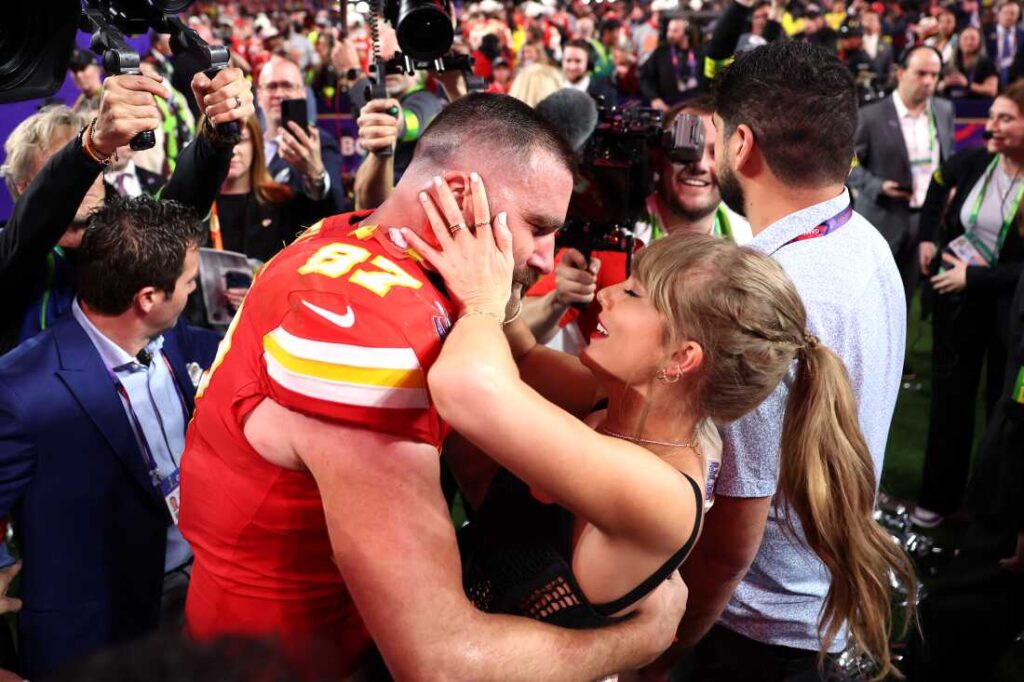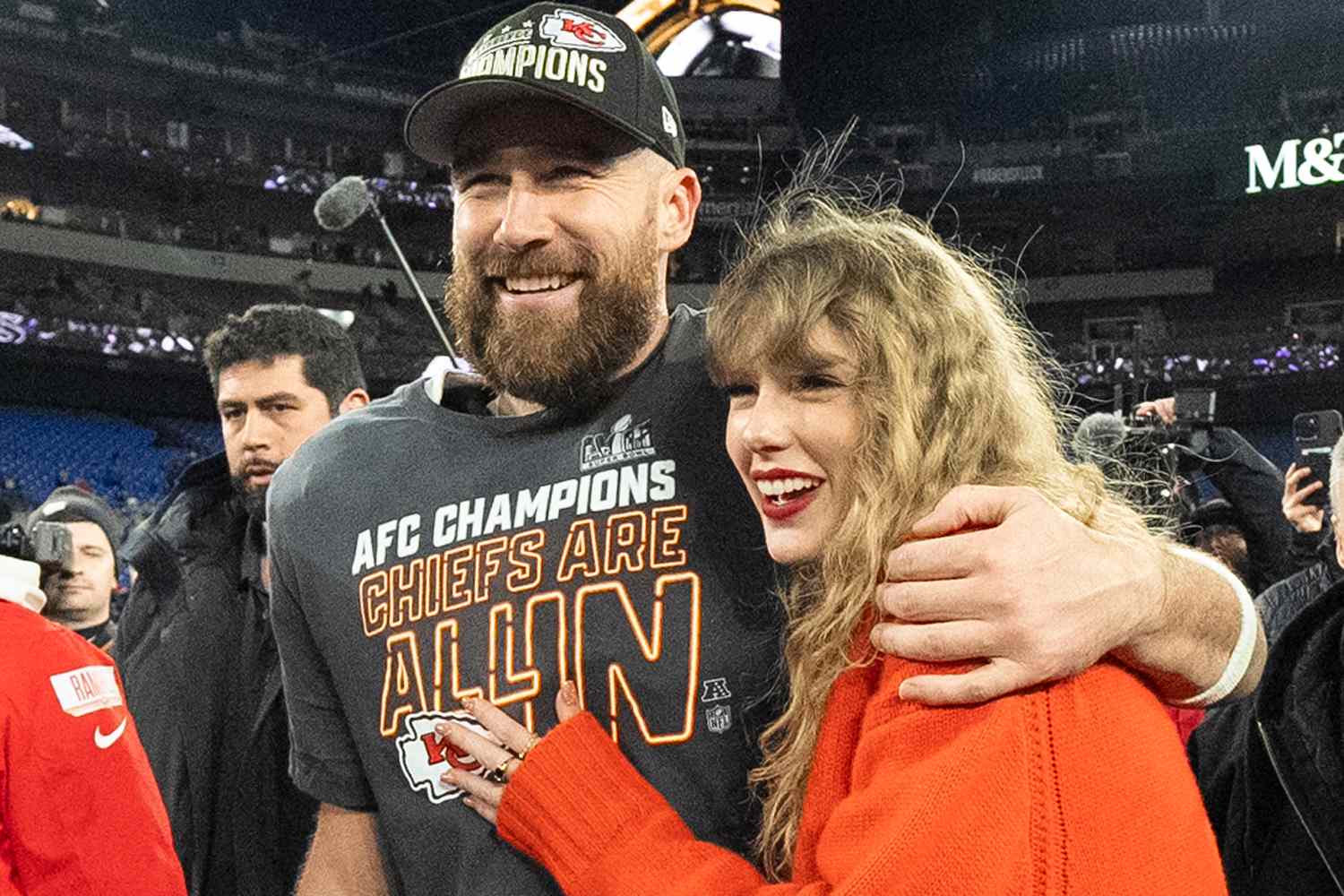Taylor Swift’s presence at Arrowhead Stadium on Sunday, October 12, once again transformed an ordinary NFL game into a global pop culture moment. The pop icon, known for her magnetic energy and record-breaking achievements, was spotted cheering on her boyfriend, Travis Kelce, as the Kansas City Chiefs faced the Detroit Lions. For fans of both football and music, her appearance was more than a celebrity cameo—it was a statement of commitment, joy, and balance amid the demanding life of a woman who has spent nearly two decades in the brightest of spotlights.
It was Swift’s third appearance at a Chiefs game this season, a moment that immediately set social media ablaze. Cameras captured her radiant smile as she mingled in the VIP suite, where she warmly embraced Ed Kelce, Travis’s father. NBC Sports, quick to document the now-iconic moment, shared the clip with the caption, “Taylor Swift, Caitlin Clark, & the Kelce family are ALL IN on Sunday Night. 🏈.” The image of Swift—her hair pulled into a casual ponytail, wearing a stylish black dress adorned with red lettering—exuded effortless confidence. She looked both glamorous and down-to-earth, perfectly blending in with the energy of the crowd while maintaining her signature grace.
Her return to the stands carried extra excitement because she had missed several recent games. Swift skipped Week 5’s matchup against the Jacksonville Jaguars, Week 3’s game against the New York Giants at MetLife Stadium, and even the season opener in Brazil, where the Chiefs played the Chargers. Those absences, however, were not due to disinterest; they were a byproduct of her packed schedule. Around the same time as the Florida game, Swift appeared on “The Tonight Show Starring Jimmy Fallon,” promoting her twelfth studio album, The Life of a Showgirl. Her conversation with Fallon, filled with laughter and reflections on her new musical direction, reminded audiences why she remains one of the most compelling entertainers of her generation.
Balancing love, career, and fame has always been a delicate act for Swift, and her Arrowhead appearance was another example of her mastering that balance. She seemed relaxed, fully engaged in the game, but her very presence elevated the atmosphere. Every time she appears at a Chiefs game, television ratings soar, merchandise sales spike, and social media erupts with commentary and fan reactions. For the NFL, Swift has become an unexpected but powerful ambassador, drawing millions of new viewers—many of whom might never have tuned into a football game before. For Swifties, these appearances feel personal, a window into their idol’s offstage life, where she is not performing for anyone but herself and the people she loves.
Yet, amid all the fun and attention, there’s an undercurrent of caution that surrounds Swift’s public outings. The joy of supporting her partner coexists with an acute awareness of the risks that come with global fame. The extreme measures she and her team take to maintain her privacy often go unnoticed by the casual observer, but every move she makes is carefully considered. During the Chiefs’ September 14 Super Bowl rematch against the Philadelphia Eagles, fans were convinced they spotted her arriving discreetly in Kansas City. Instead of her usual tunnel entrance, cellphone footage captured her entourage—including her mother, Andrea Swift, her brother, Austin Swift, and her bodyguard—walking behind a portable black wall. It was a clear attempt to create a barrier between Swift and prying eyes, an acknowledgment of just how vulnerable her position can be.
The need for such privacy isn’t without reason. Just days after that game, news emerged that Swift had sought legal protection from a man accused of stalking her. On September 23, a Los Angeles judge granted her a five-year restraining order against Brian Jason Wagner, a 45-year-old individual who had allegedly shown up repeatedly at her home. Court documents revealed unsettling details: Wagner had sent numerous disturbing messages to Swift and her staff, insisting that she was the mother of his child. These delusional and threatening communications left Swift in constant fear for her safety and that of her family. In her petition to the court, she described living with “a fear of imminent harm,” a phrase that captures the relentless anxiety that can accompany fame of her magnitude.
The restraining order was comprehensive. It prohibited Wagner from contacting Swift in any form, required him to surrender all firearms, and mandated that he stay at least 100 yards away from her residence, workplace, and vehicles. Wagner did not appear at the court hearing, but the ruling underscored the seriousness of the threat. For Swift, this was not an isolated incident—it was another chapter in a long history of unwanted invasions of privacy that have punctuated her career. From intruders breaking into her properties to online harassment campaigns, she has endured levels of intrusion few could imagine. Yet she continues to face these challenges with strength and composure, refusing to let fear dictate her life.
Her decision to attend games despite these challenges is, in many ways, an act of quiet defiance. It’s her way of saying that she will not allow fame—or the dangers that come with it—to rob her of ordinary joys. The sight of her cheering from the stands, laughing with the Kelce family, and engaging with fans from afar is a powerful reminder that behind the celebrity persona lies a person longing for connection, normalcy, and love.
Taylor Swift’s romance with Travis Kelce has captivated the world, not just because it involves two of the most successful figures in their respective fields, but because it feels refreshingly genuine. The relationship began in late 2023 and quickly became one of the most discussed love stories in modern pop culture. Their interactions, whether at games, concerts, or in interviews, carry an easygoing warmth that fans find endearing. Kelce has spoken openly about his admiration for Swift’s drive and creativity, while Swift has embraced his world with grace, blending seamlessly into the community that surrounds him.
For both of them, this relationship exists under the scrutiny of millions, yet they appear grounded. Kelce’s public affection and Swift’s visible support speak to a connection that goes beyond performance or publicity. In a world where celebrity relationships often feel manufactured, theirs stands out for its sincerity. When Swift attends a game, she does so not as a global superstar chasing headlines but as a woman cheering for her partner, clapping and smiling like any other fan in the stands.
Her influence, however, is impossible to ignore. Each time she’s seen at a game, NFL commentators mention her, television cameras find her multiple times during the broadcast, and social media lights up with memes and commentary. Some critics argue that the league focuses too much on her rather than the sport itself, but the overwhelming response from fans has been positive. For many, her appearances have added a new dimension to the game, making it a shared experience for diverse audiences—sports fans, music lovers, and curious onlookers alike.
Swift’s fashion choices at these events also fuel discussion. Her game-day outfits—carefully curated yet seemingly effortless—carry layers of meaning. The black Chiefs dress with red lettering that she wore at Arrowhead was a subtle nod to team spirit while still exuding her personal style. It was bold but understated, celebratory yet elegant, a perfect reflection of how she navigates public appearances: always mindful, always herself. Every look she debuts becomes part of the broader narrative of her evolving image—an image that continues to evolve as she transitions from pop megastar to cultural icon.

Still, beneath the glamour, there’s an unmistakable tension. Swift’s insistence on privacy, symbolized by the portable walls and legal actions, contrasts sharply with the public’s hunger to see more of her life. Her fame is unlike almost anyone else’s, spanning generations, continents, and genres. Yet it is precisely this scale of adoration that makes her vulnerable. For all the power and privilege her status affords her, it also strips away the simple freedom to exist without scrutiny.
The restraining order serves as a painful reminder of that duality. It represents both her ability to protect herself through legal means and the constant threat that shadows her success. Few artists have navigated fame as skillfully as Swift has, transforming personal pain into universal art, but even she cannot fully shield herself from the darker sides of adoration. Her candid admission in court documents about living in fear adds a sobering dimension to the glittering headlines about her romantic life and professional triumphs.
Her resilience, though, remains extraordinary. For years, Swift has turned challenges into creative fuel, using her music to tell stories of survival, heartbreak, empowerment, and renewal. Albums like Reputation and Lover explored themes of reclaiming privacy and identity, while Folklore and Evermore showcased her introspective storytelling during a time of global isolation. Now, with The Life of a Showgirl, she appears to be embracing the duality of her existence—an artist who thrives in the spotlight yet understands its price.
Seeing her at Arrowhead, surrounded by cheers and flashing lights, one can’t help but reflect on how far she has come. From her teenage years in Nashville to her global superstardom, she has remained remarkably grounded, often crediting her family for keeping her steady. Her bond with her mother Andrea, who has been a constant presence through every era, is particularly strong. Andrea’s appearance at the Kansas City game behind that portable wall wasn’t just about logistics—it was symbolic of the close-knit family unit that has always protected Swift from the chaos of fame.
The public’s fascination with Swift’s life isn’t likely to fade anytime soon. Every public sighting, lyric interpretation, and romantic milestone becomes part of a collective cultural dialogue. But the deeper story lies in her quiet strength—the way she continues to show up, smile, and live her life despite the challenges that would overwhelm most people. The contrast between the cheering crowds at Arrowhead and the somber legal proceedings in Los Angeles encapsulates the dual worlds she navigates daily. One is filled with celebration, music, and love; the other demands constant vigilance and courage.
What makes Swift’s story so compelling is not just her talent but her humanity. She experiences fear, joy, exhaustion, and elation like anyone else. Yet she carries these emotions with a grace that inspires millions. Her appearance at Arrowhead was more than a celebrity sighting; it was a glimpse of a woman who, despite unimaginable fame, continues to find meaning in the simplest moments—watching a game, laughing with family, and cheering for someone she loves.
As the NFL season progresses, fans will undoubtedly watch for her in the stands again. Each time she appears, she turns a sports event into something larger—a cultural moment that blends music, romance, and resilience. But beyond the viral clips and trending hashtags, there’s a quieter truth: Taylor Swift is still just trying to live her life on her own terms. She has learned to balance the dazzling highs of success with the sobering need for safety, to savor love while defending her boundaries, to be visible without being exposed.

That’s what made her return to Arrowhead so powerful. It wasn’t just about football or celebrity spectacle. It was about Taylor Swift, the woman, carving out joy in a life that often demands caution. It was about presence—the kind that matters not just to fans but to herself. Watching her smile, cheer, and embrace the moment was a reminder that even in a world defined by fame, the most beautiful victories are the personal ones.



